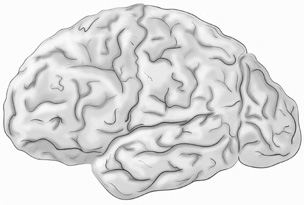
There will never be anything developed by mankind that approximates the power and efficiency of the human brain.
We know that the human brain is a wonderfully complex system that permits our every thought, emotion, and movement. It is very important for you to learn about the basics of your brain and how your brain actually works to grasp the importance of the brain health lifestyle. This chapter is dedicated to helping you understand how your own brain works and how you really have an important role in being able to shape your own brain for health.
The study of the human brain can be a very intimidating undertaking, and this might actually keep some from even trying to learn. I want you to realize that your brain is really about who you are. If you can personalize this brilliant system that sits within your skull, you can begin the process of learning about you. There are actually some easy methods to learn about the structures and functions of your brain: I teach the basics of the brain using some simple techniques that organize the brain into different sections. This typically makes the learning quite simple and interesting. Give it a try and learn something new about yourself.
The first learning technique is to think of the brain divided into a “top-down” orientation, with cortex at the top and the subcortex at the bottom. While these two regions of the brain are distinct, each with specific responsibilities, they are also integrated, helping the brain to operate like a symphony.
Your brain weighs two to four pounds and is made up of gray matter and white matter. The gray matter tends to be contained in an area of your brain called the cortex, a word that translates to “bark of a tree.” Your cortex (see Figure 2.1) is a convoluted mass of cells with folds and flaps that sits snug within your skull. The white matter is situated more deeply in the brain, beneath the cortex, and helps to bridge or connect different regions of the brain. White matter helps to propel information and to insulate cells and nerve tracts.
It developed from the back to the front, meaning the front part of your cortex is the most recent member or region of your brain to develop, evolutionally speaking. The cortex is primarily responsible for your most complex thinking abilities, including memory, language, planning, concept formation, problem solving, spatial representation, auditory and visual processing, mood, and personality. Processing in the cortex tends to be conscious and intentional. For example, the cortex is responsible for your reading this book at this very moment—your intent to educate yourself about brain health is driven by your cortex.
FIGURE 2.1 THE CEREBRAL CORTEX

The cortex is generally organized by four primary regions, or lobes: the frontal, temporal, parietal, and occipital (see Figure 2.2). Each of these four lobes has specific behaviors and functions primary to its region. For example, the frontal lobes are also known as the executive system since they help execute behavior, organize behavior, plan, conceptualize, maintain cognitive flexibility, and stabilize mood. Your personality is thought to reside in the frontal region of your brain. Your temporal lobes are the site of your auditory brain, memory and new learning, language, and perhaps religiosity. Your parietal lobes help you with orientation to space, memory, reading and writing, mathematics, and appreciation of left versus right. Finally, your occipital lobes help you to see, discriminate what you see, and perceive.
FIGURE 2.2 THE FOUR LOBES OF THE BRAIN
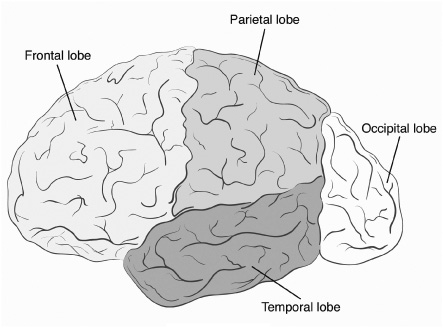
Sitting just under the cortex and on top of the ascending brain stem are a number of smaller and generally more primitive structures (relative to the cortex) known as the subcortex. Your subcortex primarily processes rote skills and procedures. Some, if not most, of the processing conducted in the subcortex is subconscious. Activities such as driving, dressing, typing, and most other routine tasks involve multiple rote procedures that are conducted at a subconscious level. Your subcortex and cortex are distinct regions of the brain, but they do not sit in isolation of one another. In fact, there are numerous connections between these two important brain regions. The brain operates as a symphony, with numerous and distinct regions harmonizing perfectly as one unit.
The second learning technique divides the brain “left to right,” appreciating that the brain is comprised of two distinct yet integrated hemispheres we call the dominant and non-dominant sides of the brain. We refer to these sides as hemispheres, and you have a left hemisphere and a right hemisphere (see Figure 2.3). Each hemisphere is connected by a bridge known as the corpus callosum. As you will learn in this section, each hemisphere has some distinct, yet not necessarily mutually exclusive, responsibilities.
Interestingly, your behaviors and functions are related primarily to one of these two hemispheres. For example, most of us—and nearly all right-handers—have language distributed primarily in the left hemisphere. We refer to the hemisphere in which language is based as the dominant hemisphere as a sign of our respect for the importance of language. Left-handers with a parent who is left-handed, a relatively rare phenomenon, have a higher probability than right-handers of having language functioning distributed primarily in the right hemisphere. They would be right-hemisphere dominant.
FIGURE 2.3 THE HEMISPHERES OF THE BRAIN
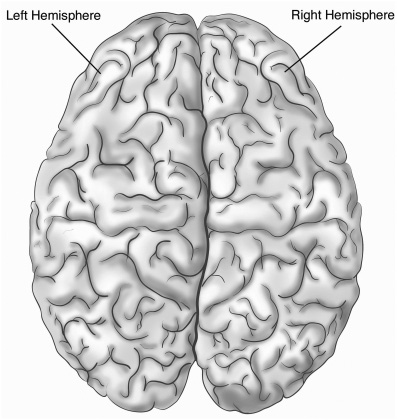
Your dominant hemisphere—left for most of us—also processes details, is task-oriented, logical, analytical, and sequences information. Most of Western civilization is built around the left hemisphere, as our classrooms are set up in rows and columns of chairs, and our cities tend to have tall buildings in rows and columns. We tend to focus more on the detail and less on the gestalt. Your non-dominant hemisphere helps you process non-language information, such as size, shapes, sounds, and space. Your ability to navigate in space, locate your car in a parking garage, or get home from a walk is an example of non-dominant function. Likewise, your ability to appreciate distinct sounds, such as a baby’s cry or a fire alarm, tends to be a process of the non-dominant hemisphere.
Your two hemispheres are connected by a bridge of cells referred to as the corpus callosum. Information crosses from one side of your brain to the other over the corpus callosum, and this is a critical part of your brain’s ability to remain so functional despite its many complex operations on a daily basis. Interestingly, the female brain is thought to have a larger corpus callosum, which underscores the notion that female brains process information differently from male brains. Females tend to utilize both sides of their brains more to process than men, who tend to rely primarily on one side, the dominant hemisphere. It is probably not coincidental that audiences across the nation always respond with the same answer to my question, “In what area of a common behavior do men and women struggle with each other on a daily basis?” The answer is communication, which you’ll learn more about in the chapters ahead.
The operation and function of your brain is ultimately conducted by the millions of brain cells we refer to as neurons. A neuron (see Figure 2.4) contains a cell body sometimes referred to as a soma, a long arm extending out from the cell body referred to as an axon, and branchlike figures called dendrites that extend out into the brain environment seeking new information to relay back to the cell body.
Indeed, information from the cell body travels down the axon into the surrounding brain, while information from the environment is gathered by the dendrites and brought back to the cell body. This ongoing exchange of information by the brain is why we refer to it as the central information processing system.
We are taught that our brains contain millions of brain cells and that each neuron can communicate with another ten thousand neurons. Interestingly, one neuron never touches another neuron, but two cells may communicate via chemicals, and this chemical marriage is called a synapse. The more synaptic connections you develop over your life span, the healthier your brain may be, because it is building up brain reserve. Brain reserve, as you will learn, may have the ability to delay the onset of neurodegenerative diseases such as Alzheimer’s.
The miracle is that your brain is dynamic and continues to be shaped and to develop. It has plasticity. As such, there is no finite capacity or limitation. In this way, your brain is very distinct and actually much superior to the fanciest of all computers because computers will always have built-in limitations and finite capacity. Your dynamic brain is shaped by environmental input across your life span, beginning in the womb. There really is no critical period of brain development, unless one considers life itself to be the measure. As you will learn in the next section, the type of environmental input your brain receives can make a difference regarding the health of your brain. You do have some control, and this is great news!
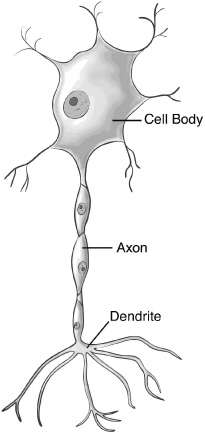
When I give lectures to the public, I always want my audience to personalize the message. This story is, after all, about you and your brain. It really does not get any more personal. Learning about oneself can be fun and challenging. There is one part of your brain that I emphasize because this structure, the hippocampus, is so critical to you and your life story. A hippocampus (see Figure 2.5) sits in the middle of each of your temporal lobes, which lie under your temples on each side of your head.
Your hippocampus, or hippocampi, for plural, as you have one in each hemisphere, takes new information in and maintains the information in a type of working buffer. If you believe the information is important and you need to store the information for an extended period of time, your hippocampus will transition the information to a specific area of your cortex. This process is not random, but rather very sophisticated, as the process of storage seems to be stimulus-based. That is, if you are learning information that is visual, your hippocampus will help store that information permanently in the visual cortex of the brain. The same process is thought to occur for the other four types of sensory input: sound, touch, taste, and smell.
Your hippocampi represent your vital learning and encoding structures, thereby helping you to build your life story and maintain your personal memories. Alzheimer’s disease, as mentioned in the previous chapter, is a leading cause of dementia, and the disease destroys very early the hippocampi of the brain. As a result, those afflicted with this terrible brain disease cannot learn new information, and they typically will repeat statements. As you will learn in the next section, your hippocampi are critical structures to brain health. Recent research suggests your hippocampi have tremendous ability, including new brain cell development referred to as neurogenesis.
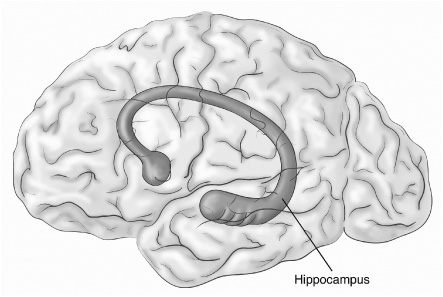
We now believe that the human brain is shaped by our environment. This means that our brain will respond to everything that we do and all that is going on around us. Something as simple as a television show or a hug, or as complicated as screaming at someone or experiencing loss and grief affects the structure and function of our brain. This wonderfully intricate marriage between environment and brain function defines neural plasticity and enables us to consider what environmental input might be best to promote our own brain health. Your understanding of this simple fact and the power of neural plasticity permits you to engage in a proactive effort to shape your own brain across your life span.
Every day we have experiences that can teach us about the function of our brain and how environment and our brain have an important and ongoing relationship. I often say that the chemistry of our brains is altered all the time, but not with pills, syringes, or liquids. Instead, words may be the single greatest neurochemical activator, and messages provided to us by our parents have a particularly long-term effect. Other environmental stimuli, such as temperature, touch from another, pain, imagery on television or the movies, emotional events, news, victory and defeat, loss, and many others affect our mood and disposition, a result of neurochemical change. Such change then typically leads to behavioral change, and this is how we lead our lives. In short, environment shapes our neurophysiology and behavior every day.
It is important you learn about the power of your brain and how it can be shaped and nurtured over the course of your life. We refer to the dynamic, constantly reorganizing, and malleable nature of your brain as brain plasticity. Understand that your brain is not a rigid or static system with a limited capacity or finite critical period for development. The power of brain plasticity permits you to implement a lifelong and proactive program to grow and promote your own brain health.
To better understand why brain plasticity is important to you, we can look to some basic findings of animal brain research. In the 1950s, research was conducted to investigate whether environment had any effect on the structure and function of the animal brain. Researchers designed a study with rodents raised in two distinct environments: an “enriched” environment versus an “unenriched” environment. Rodents were raised in one of these two environments, and then their brains were analyzed and compared at autopsy. Results yielded significant differences in the brains of these rodents. Specifically, rodents raised in an enriched environment had a larger cortex, more cellular connections, called synapses, that lead to brain reserve, and developed new brain cells, called neurogenesis, in the hippocampus, the structure critical to new learning and memory.
I became interested in this work, and I wanted to know how researchers defined an enriched environment. My review of this work suggests three factors were critical to the enriched environment: socialization (animals had to have other animals of their own kind in the environment); physical activity (animals had a running wheel to exercise on); and mental stimulation (there were toys in the environment animals could play and interact with). Animals raised in unenriched environments were raised in isolation, had no running wheel, and had no toys to play with. While this research offered highly significant and important findings regarding the effects of the environment on brain structure in the animal, the critical issue of whether the same findings could be established for humans remained unknown.
When thinking about a proactive brain health lifestyle, I believe the three critical factors of the enriched environment found in the animal studies are equally important to humans. Plenty of research supports the role of socialization, physical activity, and mental stimulation in reducing the risk of dementia in humans. However, the human organism is more complex than rodents and is stimulated by environmental input that is also more complex in nature. As you will learn in later chapters, my brain health lifestyle recognizes the complexity of the human brain by including two new factors, nutrition and spirituality, in addition to the three factors established from the animal literature.
It was not until the late nineties that a landmark study discovered that the human brain has the ability to generate new brain cells. This study was a threshold moment for our species, as it confronted traditional thought that the human brain was a rigid system with no ability to regenerate. We had always believed the brain was born with all of its brain cells, that the human brain lost brain cells on a daily basis, and that our brains did not replace the lost cells with new ones. The study also indicated that the new brain cells were generated in the human hippocampus, analogous in animals to an area neurogenesis was found in the animal brain. Today, research is ongoing to determine if neurogenesis occurs in other regions of the human brain or if it is specific to the hippocampus.
New brain cell development is one outcome of a brain with plasticity. Remember, plasticity refers to a brain that is dynamic, constantly reorganizing, and malleable. The human brain, therefore, is now thought to possess the same type of neural plasticity as the rodent brain. Interestingly, the animal studies were conducted on rodents across their life span with an equivalent human age of seventy or eighty. A human brain that generates new brain cells mandates a curiosity of how this wonderful adaptive ability occurs. We can return to the animal studies to derive some answers to this question. The enriched environment led to new brain cell development in the hippocampus of the animal. The three critical factors important to the enriched environment in this study included socialization, physical activity, and mental stimulation. Therefore, it makes sense to ask if the human brain is similarly affected by environment and if the enriched environment promotes positive brain changes in the human.
As you will read in the next chapter, there is good reason to believe that the human brain benefits from a novel and complex environment. Similar to the enriched environment discussed in the animal research above, novelty and complexity infers stimulation that demands more of the human cerebral cortex and increases the potential for development of brain reserve. Stimuli that are novel and complex require the cortex to be engaged, as the brain has either not been exposed to the information before or it has not mastered the information. In contrast, passive, rote talents or overlearned information rely more on the subcortex and are not thought to be as brain health promoting. It is also important to know that the first potential enriched environment is the womb and that the type of environment you expose your brain to will have consequences your entire life. The miracle of brain plasticity does not end at a particular age. Indeed, the human brain probably does not know its chronological age and will demand and benefit from enriched environments at every age. The major point of this section is that you are strongly encouraged and empowered to expose your brain to the novel and complex every day regardless of your age!
Brain reserve is a well-known concept that refers to a buildup of brain cell connections that serves to assist the brain in the battle against neurodegenerative diseases. To better understand brain reserve, consider the following simple analogy that I use in my lectures on the human brain. Imagine flying in an airplane nearly a thousand feet above the ground. As you peer out your window down at the ground, you will see two very distinct scenes. The first scene is a jungle where there are so many trees you cannot see the ground. The second scene is an island with one palm tree blowing slowly in the wind. You want your brain to be like the jungle, the lush foliage symbolizing a tremendous number of synaptic connections. This is referred to as synaptic density and is a direct measure of brain reserve. You do not want your brain to look like the island with one palm tree. The reason is also simple. Think of Alzheimer’s or other types of dementia or brain disease as a weed-whacker: the disease will invade the brain and begin to cut down the neurons and synaptic connections. This occurs just like a weed-whacker cutting through the weeds around your house. If your brain looks like a jungle, filled with synaptic connections, it will take Alzheimer’s or another brain disease a long time to show its ugly clinical face. However, if your brain looks like the island with one palm tree, the clinical signs of Alzheimer’s will manifest quickly because there is no reserve to fight it off.
Indeed, some research has shown that even though brains are diagnosed with Alzheimer’s at autopsy due to the presence of neuropathological markers such as tangles and plaques, a significant number of these persons never demonstrated the clinical aspects of the disease in life. This is explained one way using the brain reserve concept. Perhaps people who never manifested Alzheimer’s in life, even though they had the neuropathologic characteristics in their brain at autopsy, had built up brain reserve to fight off or delay the onset of the disease.
The power of brain reserve to stave off the effects of Alzheimer’s is further supported by findings that relate higher education and occupational levels to lower risk of Alzheimer’s. For those with high education or occupation levels who do manifest Alzheimer’s, their disease begins to emerge later on than for those without this kind of background, and once the disease manifests, they die soon after. The theoretical reason for this is that when the disease presents clinically, it is already advanced into the final stage because the person’s brain reserve had been fighting it off.
Educational settings and workplace settings are good examples of environments that can be enriched. You expose your brain to these environments frequently across over the course of your life. Each of these two environments provides the opportunity for you to engage in a novel and complex setting that promotes the development of brain reserve. To the extent that these environments or other settings become rote and passive, brain reserve will not be as developed, and the overall health benefit for your brain is not enhanced.
It is your personal challenge to expose your brain to novel and complex experiences and enriched environments on a daily basis. Studies suggest the earlier in life you begin to expose yourself to enriched environments, the greater the health benefit to your brain—even well into your late life. This finding is supported by research that demonstrates that having a higher IQ in childhood and young adulthood reveals a reduced risk of Alzheimer’s and other brain health issues later in life. Language development in young adulthood also reveals a reduced risk of neuropathologic changes in the brain, while those who have passive lifestyles in their forties show an increased risk of Alzheimer’s and other brain disorders later on in life.
Passive lifestyle is defined by a list of activities that do not require much in the way of cortical activation. One example on the list was television viewing, a behavior that tends to be rather mundane and nonengaging in most cases. Passivity can be thought of as using the subcortex primarily when we are engaged in routines, rote processes, and even subconscious behaviors. Active behaviors are more brain health promoting because we are stimulating our cortex with conscious and complex thinking that helps to build brain reserve. Brain health promotion is about the activation of the cortex through completion of tasks that are “complex and novel.”
These findings on humans support the idea that diseases of the brain that manifest late in life may actually begin early in life. Further, these findings suggest we can become involved very early in life with a proactive lifestyle that promotes brain health and that helps to reduce the risk of Alzheimer’s and related dementias later in life. It is important to prioritize a proactive lifestyle for brain health regardless of your age, to embrace the power of brain plasticity and development of brain reserve, and to have fun in the process of caring for your brain!
You have now accomplished something you may not have thought possible: you have learned the basics of your brain. In fact, you now know more about the human brain and yourself than the vast majority of other people. This new knowledge enables you to really appreciate the importance of a proactive brain health lifestyle because you now can understand how what you do quite literally impacts the very structures and functions of your brain. Behavioral change is most likely to occur if one personalizes the message and is told why something will help him or her. You have personalized the message, and your new knowledge of brain basics enables you to move forward fully prepared for not only understanding the brain health lifestyle but being able to apply it with great understanding.
Now that you have basic knowledge of how the brain works, you probably feel empowered and excited to learn more!